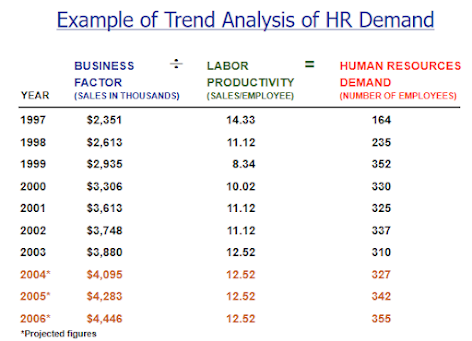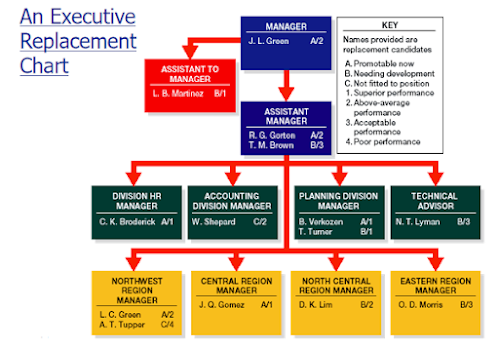Human Resources Planning
Human Resources Planning (HRP)
> Process of anticipating and making provision for the movement (flow) of people into, within, and out of an organization.
> HRP’s purpose is the the effective deployment of human resources through:
- Anticipating organizational labor supply and demand.
- Providing expanded employment opportunities for women, minorities, and the disabled.
- Guiding the development and training the workforce.
HRP and Strategic Planning
- Strategic Analysis
What human resources are needed and what are available?
- Strategic Formulation
What is required and necessary in support of human resources?
- Strategic Implementation
How will the human resources be allocated?
Mapping an Organization’s Human Capital Architecture
- Core knowledge workers
> Employees who have firm-specific skills that are directly linked to the company’s strategy.
Example: Senior software programmer
- Traditional job-based employees
> Employees with skills to perform a predefined job that are quite valuable to a company, but not unique.
Example: Security guard
- Contract labor
> Employees whose skills are of less strategic value and generally available to all firms.
Example: General electrician
- Alliance/partners
> Individuals and groups with unique skills, but those skills are not directly related to a company’s core strategy.
Example: Independent product label designer
Ensuring the Fit between HR and Strategy
- External Fit (or External Alignment)
> Focuses on the connection between the business objectives and the major initiatives in HR.
-Internal Fit (or Internal Alignment)
> Aligning HR practices with one another to establish a configuration that is mutually reinforcing.
Strategic Flexibility
- Organizational Capability
> Capacity of the organization to act and change in pursuit of sustainable competitive advantage.
> Coordination flexibility
The ability to rapidly reallocate resources to new or changing needs.
> Resource flexibility
Having human resources who can do many different things in different ways.
HRP and Environmental Scanning
- Environmental Scanning
>The systematic monitoring of the major external forces influencing the organization.
1. Economic factors: general and regional conditions
2. Competitive trends: new processes, services, and innovations
3. Technological changes: robotics and office automation
4. Political and legislative issues: laws and administrative rulings
5. Social concerns: child care and educational priorities
6. Demographic trends: age, composition,and literacy
Scanning the Internal Environment
- Cultural Audits
> Audits of the culture and quality of work life in an organization.
1. How do employees spend their time?
2. How do they interact with each other?
3. Are employees empowered?
4. What is the predominant leadership style of managers?
5. How do employees advance within the organization?
- Benchmarking
>The process of comparing the organization’s processes and practices with those of other companies.
The Top Ten Measures Of Human Capital
1. Your most important issues
2. Human capital value added
3. Human capital ROI
4. Separation cost
5. Voluntary separation rate
6. Total labor-cost/revenue percentage
7. Total compensation/revenue percentage
8. Training investment factor
9. Time to start
10. Revenue factor
Quantitative Approach: Trend Analysis
> Forecasting labor demand based on an organizational index such as sales:
-Select a business factor that best predicts human resources needs.
-Plot the business factor in relation to the number of employees to determine the labor productivity ratio.
- Compute the productivity ratio for the past five years.
- Calculate human resources demand by multiplying the business factor by the productivity ratio.
- Project human resources demand out to the target year(s).
Qualitative Approaches to Demand Forecasting
- Management Forecasts
The opinions (judgments) of supervisors, department managers, experts, or others knowledgeable about the organization’s future employment needs.
- Delphi Technique
An attempt to decrease the subjectivity of forecasts by soliciting and summarizing the judgments of a preselected group of individuals.
The final forecast represents a composite group judgment.
Forecasting Supply of Employees: Internal Labor Supply
- Staffing Tables
- Markov Analysis
- Skill Inventories
- Replacement Charts
- Succession Planning
Forecasting Internal Labor Supply
- Staffing Tables
Graphic representations of all organizational jobs, along with the numbers of employees currently occupying those jobs and future (monthly or yearly) employment requirements.
- Markov Analysis
A method for tracking the pattern of employee movements through various jobs.
Internal Demand Forecasting Tools
- Skill Inventories
Files of personnel education, experience, interests, skills, etc., that allow managers to quickly match job openings with employee backgrounds.
- Replacement Charts
Listings of current jobholders and persons who are potential replacements if an opening occurs.
- Succession Planning
The process of identifying, developing, and tracking key individuals for executive positions.
Forecasting Supply of Employees: External Labor Supply
- Factors Influencing the External Labor Supply:
- Demographic changes in the population
- National and regional economics
- Education level of the workforce
- Demand for specific employee skills
- Population mobility
- Governmental policies
Labor Supply and Demand Issues
- Balancing supply and demand considerations
- Organizational downsizing
- Making layoff decisions
Recruiting within the Organization
- Benefits of a promotion-from-within policy:
- Capitalizes on past investments (recruiting, selecting, training, and developing) in current employees.
- Rewards past performance and encourages continued commitment to the organization.
- Signals to employees that similar efforts by them will lead to promotion.
- Fosters advancement of members of protected classes within an organization.
- Limitations of a promotion-from-within policy:
- Current employees may lack the knowledge, experience or skills needed for placement in the vacant/new position.
- The hazards of inbreeding of ideas and attitudes (“employee cloning”) increase when no outsiders are considered for hiring.
- The organization has exhausted its supply of viable internal candidates and must seek additional employees in the external job market.
Internal Methods of Locating Qualified Job Candidates
- Human Resources Information Systems (HRIS), Database systems containing the records and qualifications of each employee that can be accessed to identify and screen candidates for an internal job opening.
- Job Posting and Bidding, Posting vacancy notices and maintaining lists of employees looking for upgraded positions.
Recruiting Outside the Organization
- Labor Market
Area from which applicants are to be recruited.
Tight market: high employment, few available workers
Loose market: low employment, many available workers
- Factors determining the relevant labor market:
1.Skills and knowledge required for a job
2. Level of compensation offered for a job
3. Reluctance of job seekers to relocate
4. Ease of commuting to workplace
5. Location of job (urban or nonurban)
Outside Sources of Recruitment
- Advertisements - Labor unions
- Unsolicited applications and resumes - Public employment agencies
- Internet recruiting - Private employment agencies
- Employee referrals - Temporary help agencies
- Executive search firms - Employee leasing
- Educational institutions
- Professional organizations
Increasing the Effectiveness of Employee Referrals
- Up the ante.
- Pay for performance.
- Tailor the program.
- Increase visibility.
- Keep the data.
- Rethink your taboos.
- Widen the program.
- Measure the results.
External Recruitment Considerations
- Sources of Organizational Recruiters
Professional HR recruiters
HR generalists
Work team members
- Requirements for Effective Recruiters
Knowledge of the recruited job’s requirements and of the organization
Training as an interviewer
Personable and competent to represent the organization
- Realistic Job Previews (RJP)
Informing applicants about all aspects of the job, including both its desirable and undesirable facets.
Positive benefits of RJP
a. Improved employee job satisfaction
b. Reduced voluntary turnover
c. Enhanced communication through honesty and openness
d. Realistic job expectations
Issues in Recruiting Protected Classes
- Recruitment of Women
Growth of women in the workplace
Increase in females in management roles
Stereotyping and gender conflicts
- Recruitment of Minorities
Educational and societal disadvantages
Retention in organizations
Affirmative action
Issues in Recruiting Protected Classes
- Recruitment of the Disabled
Increasing numbers of disabled in the workforce
Stereotyping of the disabled versus their superior records for dependability, attendance, motivation and performance
Accommodations for physical and mental disabilities
- Recruitment of Older People
Increasingly returning to the workplace
Have valued knowledge, experience, flexibility and reliability as employees










No comments:
Post a Comment